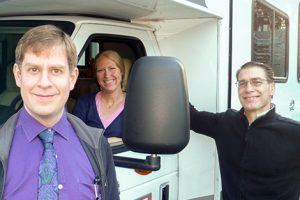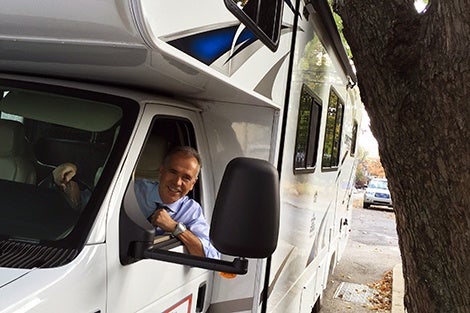December 5, 2016—Road trip! This fall, four researchers from Harvard T.H. Chan School of Public Health and Massachusetts General Hospital in Boston hopped into a 32-foot-long RV and began motoring down the East Coast in order to meet with 51 participants from the Nurses’ Health Studies and Health Professionals Follow-Up Study. Their aim was to conduct neurological examinations that will help them learn more about the early symptoms of Parkinson’s disease.
The subjects are among the thousands of health professionals who have dutifully been filling out questionnaires about their health and habits for decades, providing data that has formed the basis of numerous research studies on risk factors for chronic diseases.

“The participants feel like they are part of our work after participating for so long, so meeting in person was exciting for us and for them,” said Alberto Ascherio, professor of epidemiology and nutrition at Harvard Chan School. Ascherio was joined by neurologist Michael Schwarzschild of Harvard Medical School and Massachusetts General Hospital, and Schwarzschild’s research fellows Jessica Baker and Christopher Stephen.
The team met with study participants who had completed questionnaires on their sense of smell and color vision—the loss of either of which may be an early symptom of Parkinson’s disease. Participants were chosen to represent a range of scores on the tests, with some having already received a Parkinson’s diagnosis, and others serving as healthy controls. The team spent an hour with each individual, conducting in-depth tests of their sense of smell and color vision, in addition to observing their ability to rise from a chair, postural stability, speed of movement, and the presence of tremors. The researchers hope to return in two years to retest participants and observe any changes.
The data they gathered from the examinations will provide important validation of the information they have collected from participants by other means, Ascherio said. “For example, several participants have reported in questionnaires that they had tremors or difficulty with movements, but to use this information properly we need to see objectively how people who report these symptoms differ from those who do not.”
Schwarzschild added that their evaluations of people “who have multiple versus no risk factors for Parkinson’s has demonstrated the feasibility and value of expanding such neurological assessments to a network of Parkinson’s specialists who can examine a large proportion of these epidemiological cohorts. “
Dodging tree branches and meeting enthusiastic volunteers
The team started their journey by heading west to Harrisburg, Penn.” They then traveled back east, making additional stops in Pennsylvania, New Jersey, New York, Connecticut, and Massachusetts. They bonded over pre-sunrise runs, Ascherio said, and worked as a team to maneuver their large vehicle around whatever obstacles the road threw in their way, from tight parking spaces to rogue tree branches. They narrowly avoided the occasional fate of a new college student traveling to Boston for the first time—getting stuck under the low overhead bridge on Storrow Drive.
“Thankfully, our GPS had second thoughts before it was too late,” Ascherio said.
Allison Gordon, a staff member with the Health Professional’s Follow-Up Study group in the Nutrition Department at Harvard Chan School, provided logistical support for the trip. She scheduled appointments and made calls to find locations near clusters of participants where the team could park their vehicle and set up shop—mostly in suburban mall parking lots.
In the weeks leading up to the trip, Gordon worried about being able to schedule enough appointments with the study participants to make the trip worth the researchers’ time, but that turned out to be a non-issue. “They were happy to reschedule prior commitments so that they could visit the mobile clinic when it was in their area. Their enthusiasm for the studies was delightful to discover.”
The mobile clinic was funded as part of a five-year grant from the Department of Defense (DoD). Ascherio explained that the DoD supports research into several health concerns that are not a direct consequence of specific risks that military personnel are exposed to, but that do affect the military population.
The Nurses’ Health Study (NHS) was launched in 1976 with more than 121,700 women, and has grown to include additional cohorts in the NHS II and NHS 3. The all-male Health Professionals Follow-Up Study began in 1986.
Photos courtesy of Michael Schwarzschild, Jessica Baker
Learn more
The Nurses’ Health Study: Celebrating 40 years of vital contributions to public health (The Nutrition Source)
The four-decade-old Nurses’ Health Study sets its sights on breast cancer (Harvard Chan School News)
Tales from a long relationship (Harvard Public Health)
